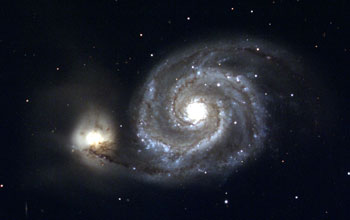Multimedia Gallery
M51, the Whirlpool Nebula, NGC5194/5195
M51, the Whirlpool Nebula, NGC5194/5195
This image was developed by combining three CCD frames that were taken using the Kitt Peak 0.9 meter telescope. By using different filters in front of the monochrome detector that correspond approximately to the primary colors red, green and blue, it is possible to recreate a true color picture. Each image was processed to correct for detector sensitivity variations, and remove incorrect regions caused by manufacturing defects or by the arrival of cosmic rays at the telescope. (Date of Image: 1991)
More about this Image
A 'drift scan' technique was used for this image, where the telescope is held fixed, not tracking against the Earth's rotation in the usual manner. As the sky passes across the detector, each row of the array is 'clocked' along to the next row in step with the apparent motion of the astronomical image. This makes it possible to take a picture of an arbitrarily long strip of the sky, and specialized telescopes exist solely to take advantage of the simplicity of a fixed, non-tracking mounting. The large size of the M51 system, famous as the first clearly recognized spiral nebula, made it necessary to use the drift scan technique.
[Orientation: N to the left, E down.
Smaller telescopes with a larger field of view are also capable of taking such pictures, but without drift techniques, and can often approach the same quality, especially with clever processing.
More About this Object
M51 (also known as Arp~85 and VV~1) comprises the large spiral galaxy NGC5194 and its smaller, barred and more amorphous companion NGC5195. Some features are better seen in a color picture: note, for example, how NGC5195 takes on a reddish tinge due to the fact that it is behind the dust-filled arm connecting it to NGC5194. M51 was the first astronomical object in which spiral structure was discerned, by the Third Earl of Rosse in 1845. The spiral arms are perhaps the most perfect 'textbook' example in any nearby galaxy and their very perfection points to the presence of a long-lasting, confining mechanism. This may be provided by the tidal pull of NGC5195, whose gravitational effects can generate the necessary spiral density waves. This pattern also shows up in radio emission, suggesting that the magnetic fields in the Whirlpool are also compressed by the density wave. The innermost core of NGC5194 contains a bright ultraviolet source, as well as one of the brightest known compact radio sources. Although smaller and less massive than our own Galaxy, M51 is considerably brighter due to recent star formation and the resultant dominance by young, hot, bright stars of types O and B. [Location: 13 27 50 +47 29 (1950.0), constellation of Canes Venatici; Distance: approximately 31 million light-years; Size: over 65000 light-years across.]
Credit: Credit: Todd Boroson/NOAO/AURA/NSF
Special Restrictions: Use of this image is restricted by the National Optical Astronomy Observatory (NOAO). For further information, see the NOAO/AURA Image Library's Conditions of Use Web page.
Images and other media in the National Science Foundation Multimedia Gallery are available for use in print and electronic material by NSF employees, members of the media, university staff, teachers and the general public. All media in the gallery are intended for personal, educational and nonprofit/non-commercial use only.
Images credited to the National Science Foundation, a federal agency, are in the public domain. The images were created by employees of the United States Government as part of their official duties or prepared by contractors as "works for hire" for NSF. You may freely use NSF-credited images and, at your discretion, credit NSF with a "Courtesy: National Science Foundation" notation.
Additional information about general usage can be found in Conditions.
Also Available:
Download the high-resolution TIF version of the image. (178 KB)
Use your mouse to right-click (Mac users may need to Ctrl-click) the link above and choose the option that will save the file or target to your computer.



